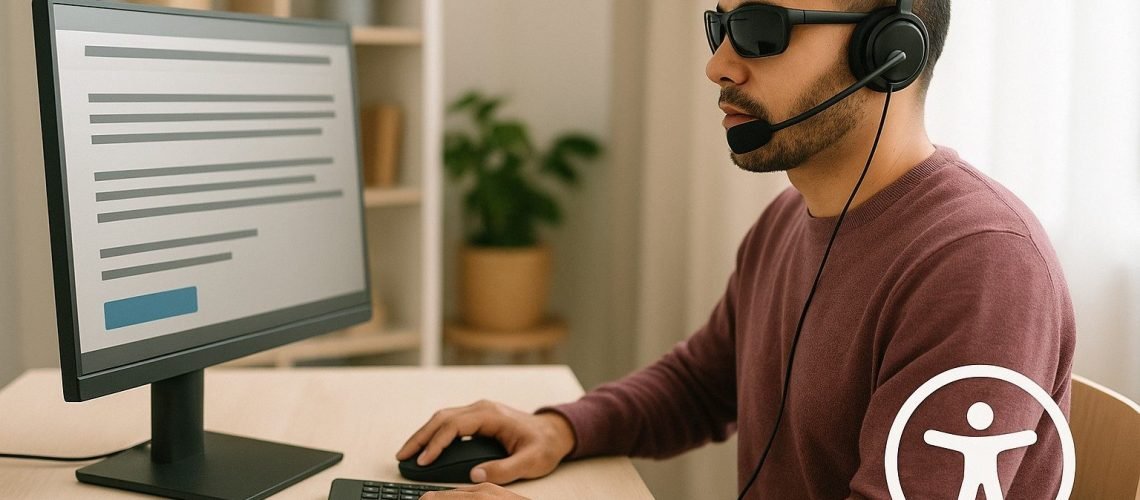How to Make Your Website Legally Compliant and Accessible to Everyone
Digital Inclusion Starts on Your Website
Web accessibility is often seen as an add-on – something you’ll get to later. But with the growing enforcement of the Americans with Disabilities Act (ADA) and evolving digital standards in the U.S., it’s clear: Accessibility is no longer optional. It’s the law. And more importantly – it’s a sign of responsibility, professionalism, and forward thinking.
Your website is not just a digital business card. It’s often the first and most important point of contact with your audience. And if that experience doesn’t work for everyone, you’re not only missing out on potential leads – you’re unintentionally excluding entire communities.
At ideary works, we believe accessibility is not a trend. It’s a commitment – to equality, to better UX, and to modern standards that reflect who you are as a business.
What Accessibility on the Web Really Means
Web accessibility means that everyone can use your website—regardless of physical, sensory, or cognitive ability. This includes people with vision or hearing impairments, motor disabilities, neurodivergent individuals, and older users experiencing age-related changes. And it affects far more people than most businesses realize.
But accessibility isn’t just a technical standard—it’s a mindset. An accessible website is clearly structured, easy to read, keyboard-navigable, screen reader-friendly, and free of digital obstacles. It’s not just built for the majority—it’s designed for everyone.

Legal Requirements – And Who Needs to Comply
In the United States, the Americans with Disabilities Act (ADA) requires that websites offering digital services—such as online booking, e-commerce, or contact forms—are accessible to users with disabilities. While the law doesn’t explicitly name websites, U.S. courts have increasingly ruled that business websites fall under Title III of the ADA if they function as public accommodations.
Organizations that serve the public, including law firms, coaches, consultants, and real estate companies, are at particular risk if their websites do not meet accessibility standards. The Web Content Accessibility Guidelines (WCAG) 2.1 serve as the international benchmark for compliance.
But even if you’re not (yet) legally required to comply, accessibility offers real benefits: better SEO rankings, faster load times, improved usability, and reduced legal risk.
Our Approach: Accessibility by Design – With Purpose and Precision
At ideary works, accessibility isn’t an afterthought — it’s built into every website we create. Each project starts with a structured audit: Where are the barriers? What can be improved? We don’t just aim for legal compliance under the ADA and WCAG 2.1 — we build websites that are clear, inclusive, and built on empathy.
Our work combines current accessibility standards with proven UX design principles that promote orientation, trust, and usability. The result? A website that not only checks the legal boxes — but genuinely works for everyone.
What You Should Do Next
If you already have a website and aren’t sure whether it’s accessible, now is the time to act. A quick, no-obligation audit can reveal key areas for improvement. And if you’re starting fresh, accessibility should be part of your strategy from day one – technically, visually, and structurally.
Because investing in digital inclusion isn’t just the legally smart thing to do – it strengthens your brand, expands your reach, and demonstrates real values.
Conclusion
Accessibility is no longer optional – it’s the new standard. And it starts exactly where your audience meets you: on your website. Prioritizing digital inclusion sends a powerful message. About professionalism. About responsibility. And about being ready for the future.
Let’s build a website that’s open to everyone – together.
Ein paar brennenden Fragen zum Schluss
When does accessibility become mandatory for websites?
In the U.S., the Americans with Disabilities Act (ADA) already requires businesses considered “public accommodations” to offer accessible digital services. Lawsuits and enforcement have increased significantly in recent years – so now is the time to act.
What does digital accessibility mean?
It means your website can be used by everyone – including people with visual, auditory, motor, or cognitive impairments. That includes screen reader compatibility, clear structure, proper contrast, and keyboard navigation.
Does every website have to be accessible?
If your website is part of your business presence – especially in law, coaching, consulting, or real estate – accessibility is not just recommended, but essential. Even smaller businesses have faced ADA-related lawsuits.
What are the benefits of having an accessible website?
Beyond legal protection, accessibility improves usability, expands your audience, boosts SEO, and shows that your brand stands for inclusivity and professionalism.
How can I make my website accessible?
The best approach is to work with specialists who follow WCAG 2.1 guidelines and understand both legal requirements and user experience. At ideary works, accessibility is built into our process – not just added later.




